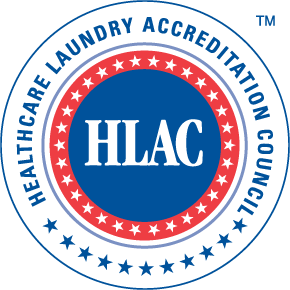HLAC Advises on Measures to Reduce Environmental Transmission of Coronavirus
Organization’s Standards align with cleaning and disinfection practices recommended by the Centers for Disease Control
PLAINFIELD, IL – February 4, 2020 – As healthcare and public policy officials grapple with effective strategies to contain the novel coronavirus outbreak, the Healthcare Laundry Accreditation Council (HLAC) has issued a reminder that established cleaning and disinfection practices can play a critical role in reducing environmental transmission and averting a medical crisis.
The 2019 coronavirus strain (2019-nCoV) is part of a family of viruses across a spectrum that runs from the “common cold” to severe respiratory illnesses such as SARS and MERS. Because it is a new permutation, researchers are still assessing the transmissibility and severity of the 2019-nCoV. However, the virus is known to be transmitted through person to person contact or spread by respiratory droplets or aerosols generated by coughing or sneezing.
Coronaviruses can easily be inactivated by commonly used disinfectants. The Centers for Disease Control and Prevention (CDC) recommends routine cleaning and disinfection procedures that are in accordance with HLAC Standards. The CDC advocates a two-step process: washing surfaces with cleaners and water and then applying an Environmental Protection Agency (EPA)-registered, hospital-grade disinfectant to frequently touched surfaces or objects. The CDC also advises that management of laundry, food service utensils, and medical waste should be performed in accordance with routine procedures.
“The 2019-nCoV is a fragile organism which is susceptible to the antimicrobial action of the established laundering process which occurs through a combination of mechanical, thermal, and chemical factors,” states Dr. Carol McLay, Infection Preventionist. “It is critical for laundry operators to reach out to their healthcare customers to ensure they understand how that hospital intends to handle linen from confirmed 2019-nCoV patients, as there is variation in policies between hospitals.”
HLAC President Linda McCurdy provided additional details regarding the role laundry processing can play in minimizing transmission risk. “Per HLAC Standards, all soiled linen should be handled as if it is contaminated,” she said. “It is imperative that laundry facility staff follow universal precautions; ensure proper personal protective equipment (PPE) with eye protection and mucous membrane protection; enforce functional separation; and ensure that soiled textiles are properly bagged. I encourage facilities, including those on-site at hospitals and medical facilities, to remind their staff of the importance of following these standards and of their essential role in reducing the risk of an epidemic.”
Laundries that adhere to the HLAC Standards are already engaged in best practices in this regard and need not deviate from their current processes. The CDC has not issued additional or special procedure directives. HLAC advises laundries to contact the hospitals they serve for current information about their procedures in handling soiled textiles, particularly those that have been exposed to the coronavirus.
About 2019-nCoV
Symptoms of 2019 n-CoV may appear any time from two days to two weeks following exposure. Common symptoms include fever, cough, and shortness of breath; in approximately 25% of cases, patients experience more severe and potentially life-threatening symptoms, such as high fever, pneumonia, respiratory failure, and kidney failure. The mortality rate is estimated at 2-3%. For additional information, see the Centers for Disease Control and Prevention’s Coronavirus Homepage or the World Health Organization’s Coronavirus resource.


